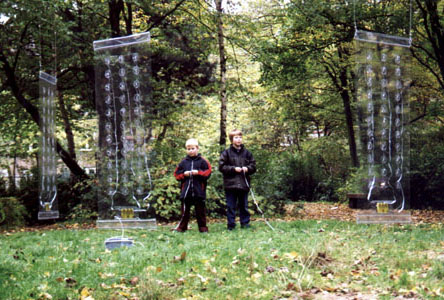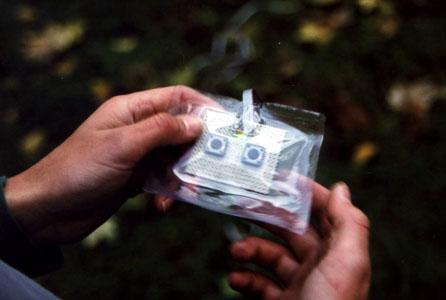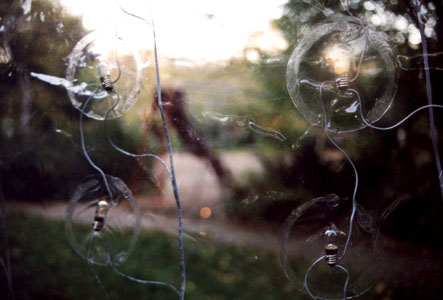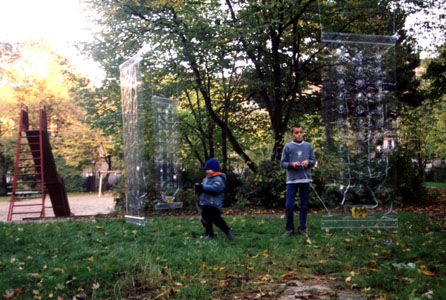 300dpi
300dpi
swingUp Games
Installation, Cologne, Germany 2001
3 Games
Plastic folio
Shink-wrapped is:
2 Stripes of acrylic glass
33 Light bulbs
Platinium chip and ATLEM Microcontroller
Keyboard (Keys with light diode)
Cable
Three plastic films, which can variably be set up as transparent walls give shape to these three computer games. By using the keyboard, the player may move the only point of light from right to left. Based on the principle of a moving light, weak points of light move up and down in the same vibrations on the three shrink-wrapped vertically set light chains. The goal of the game is to head for the vibrating lights as skillfully as one is able to, so that the bright points of light are pushed to the top. „swingUp Games“ are designed to be easy to carry and easy to install. These qualities allow many improvised „exhibitions“ at the most different places, also in public space. The „swingUp Games“ are also designed to catch attention and therefore to enhance communication between most different people. The film as a membrane of perception, a platform for the „antenna“ of structure, also enhancing stimulation and enticement of the wrappings of consumer products, as a over-rated reality. Moving from church windows to celluloid films to the overhead folio and portfolios, in future to handy held ebooks and folio-displays, provided by solar folios. The light is absorbed electrically, digitally, logically processed and passed on as a sign of light. In „SwingUp Games“ the foil itself, with its hand manufactured lips and welding seams, becomes a material object, at which dirt-pure sticks and drops from condensation are formed. Contents of the foil are minimized, so that the balance between „foil“ and „reality“ remains. The work reminds of the first video games in the pocket format, which came out in the 80ies, and could stay on the market as cheap products until today besides Game Boy and games for cell phones. In these games structure and motive for playing are usually connected directly to each other, by the appearance of the illuminations as images. While in „SwingUp Games“ the playstructure is separated formally as abstract light play from the motive for playing. Now this motive is formed by the environment, as background for the transparent games.
Drei Plastikfolien, die sich als transparente Raumteiler variabel installieren lassen, bilden den Rahmen für drei Computerspiele. Die SpielerIn kann mit der Tastatur den einzigen hellen Lichtpunkt nach rechts und links bewegen. Auf den dreien, in die Folie eingeschweißten, vertikalen Lichterketten bewegen sich nach dem Prinzip eines Lauflichtes schwache Lichtpunkte in immer gleichen Schwingungen auf und ab. Ziel des Spieles ist es, die schwingenden Lichter so geschickt anzusteuern, das sie den hellen Lichtpunkt ganz nach oben befördern. Die swingUp Games sind so konzipiert, daß sie sich leicht transportieren und installieren lassen. Diese Eigenschaften erlauben es, zahlreiche, improvisierte "Ausstellungen" an den verschiedensten Orten, unter anderem im öffentlichen Raum zu realisieren. Die swingUp Games sind darauf ausgerichtet innerhalb eines breiten Publikums als Kommunikationspunkt zu fungieren. Die Folie als Membran der Wahrnehmung, als Träger von Rezeptionsstrukturen, als reizsteigernde, verführende Verpackung von Konsumprodukten, als überhöhte Realität. Vom Kirchenfenster über den Zelluoidfilm zur Overhadfolie und Portfolio, in Zukunft handeheld-ebook und Foliendisplays versorgt von Solarfolien. Das Licht wird absorbiert elektrisch, digital, logisch verarbeitet und als Lichtzeichen weitergegeben. In den SwingUp Games wird die Folie selbst mit ihren von Hand gefertigten Schnittkanten und Schweißnähten, zu einem realen Gegenstand, an dem Dreckspuren zurückbleiben und sich Tropfen mit Kondenswasser bilden. Die Folieninhalte sind minimiert, so daß eine Balance zwischen "Folie" und "Realität" erhalten bleibt. Die Arbeiten erinnern, an die ersten Computerspiele im Pocketformat, die in den Achziger-Jahren auf den Markt kamen, und sich bis heute neben Game-Boy und Handyspielen als Billigprodukte halten konnten. In diesen Spielen werden meist Spielstruktur und Spielmotiv unmittelbar mit einander verbunden, indem die Leuchtfelder mit Symbolen versehen sind. In den swingUp Games dagegen wird die Spielstruktur als abstraktes Lichtspiel formal vom Spielmotiv getrennt. Zum Spielmotiv wird die Umgebung, der Hintergrund der transparenten Flächen.





(^home), (nächste Installation)